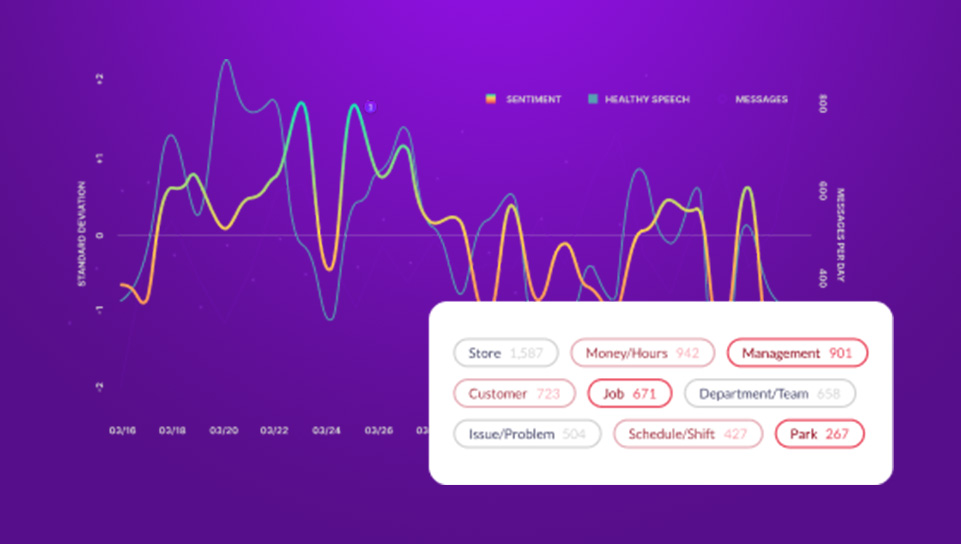4 Ways a Flight Risk Employee Can Harm Your Organization
by Aware
Flight risks are invisible liabilities that can live in your ecosystem, spreading toxic employee behavior and creating a toxic culture throughout the workplace. . Here’s four ways that flight risk employees can bring harm to your organization, and how to get ahead of a potentially malicious flight risk—before they hurt your business.
What is a flight risk employee?
A flight risk employee is someone who is likely to leave their current job or company. This can be due to a variety of factors such as job dissatisfaction, a better offer elsewhere, or a lack of career advancement opportunities. Not all flight risk employees are potential malicious actors, but malicious insiders can pose a unique and critical threat to the organization.
4 Potential Impacts of a Flight Risk
A flight risk is any employee that is likely to leave a company. They may exhibit signs of low engagement and a dissatisfaction with workplace culture. In the context of this conversation, we are focusing on those departing workers with malicious intentions, as they can wreak havoc on a company reputation and culture.
Poisoned Workplace Culture
A disengaged, spiteful employee can potentially create a toxic workplace. Negative attitude spreads like a virus and impacts other employees, multiplying with each interaction. This can cause a decline in performance within a department, as well as a higher turnover.
Skills Gap in a Crucial Company Position
Upon leaving the company, former employees can take with them skills that are integral to daily operations which can hinder workplace productivity. This void may be expensive to fill because highly sought-after experience can be difficult to replace.
Former Employees Can Make Headlines
Former employees might go to the media with narratives of what drove them to leave a company. Former staff at Wells Fargo were treated poorly and the toxic culture led to several stories being spread through mainstream media.
Unhappy, Departing Workers May Become Insider Threats
While transitioning from a company, workers who may have high levels of access to permissions, company data, and customer information can become insider threats—potentially costing a company millions or hindering brand reputation. Here are just a few examples:
- Alphabet Inc.’s self- driving car company, Waymo, was sued to the tune of $245 million when one of its former engineers became chief of Uber self-driving car initiative, taking with him and sharing some of Waymo’s trade secrets.
- A former employee of Apple is accused of downloading more than 40 gigabytes of Apple’s intellectual property onto his wife’s laptop prior to leaving the company.
How to Get in Front of a Potentially Malicious Flight Risk
Collaboration tools such as Slack, Workplace from Meta, and Microsoft Teams provide a space to interact—similar to human-to-human conversation. These tools provide an amazing opportunity for leaders when it comes to identifying potential threats as employees exit a company.
Compared to email, collaboration platforms offer a more real-time way to communicate in the workplace. It also allows for meaningful insights into the day-to-day of employee activities.
Employees tend to interact in a more casual and candid manner on collaboration platforms than more traditional styles of communication. Due to employee usage of collaboration platforms, there is an opportunity for employers to leverage a private message monitoring and insights tool to tap into unstructured employee communication data and understand the overall employee sentiment.
Through observing behavior or behavioral anomalies among individual employees, leaders can identify potential malicious flight risks from the organization and respond in order to protect both the company and fellow employees. Learn about other forms of toxic human behavior risks in the workplace and workstream collaboration analytics tool can help mitigate the risks.
The Industry Leading Enterprise Collaboration Monitoring & Insights Solution
Aware's AI-driven technology analyzes workplace communication content and file shares, delivering a real-time solution for understanding content and information sharing.
Leaders can configure custom actions based on instances of shared content and if an issue arises, they can investigate—bias free. With shared content monitoring functionality, the team can also pull relevant messages and leverage additional context to identify the root of the insider threat collaboration.
Discover potential blind spots in your organization.
Download the Human Behavior Risk Analysis Report to better understand employee behavior that could be threatening your organization's security, compliance and culture.








